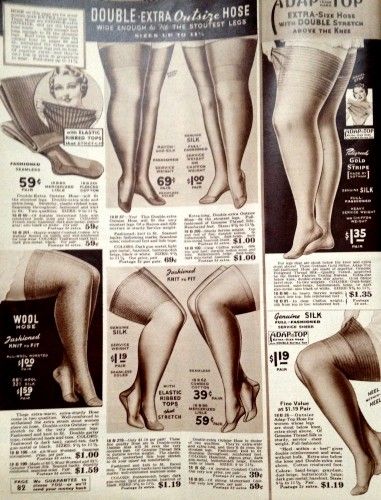The Evolution of Women’s Stockings: From Silk to Nylon
In the 1940s, women’s fashion underwent a significant shift due to the impact of World War II on the availability of materials. One particular item that saw a major change during this time was women’s stockings. Before the 1940s, it was customary for women to wear silk stockings whenever they left the house, and it was considered inappropriate to be bare-legged in public. However, the war led to shortages of silk, and new materials such as nylon became popular alternatives for stockings.
The Era of Silk Stockings
Prior to the 1940s, silk stockings were an essential part of a woman’s wardrobe. They were seen as a symbol of femininity and sophistication, and it was uncommon for women to leave the house without wearing a pair. In fact, the idea of being bare-legged in public was considered improper, unless one was at the beach or engaging in recreational activities. Silk stockings were a luxury item, often associated with elegance and class.
As a result of World War II, silk became scarce, and the production of silk stockings declined. Women were forced to seek alternative options for hosiery, paving the way for the introduction of new materials such as nylon.
The Emergence of Nylon Stockings
The invention of nylon revolutionized the hosiery industry in the 1940s. Nylon stockings were introduced as a more affordable and durable alternative to silk stockings. Their availability and affordability made them accessible to a wider range of women, and they quickly gained popularity in the fashion world.
Nylon stockings were known for their strength and elasticity, which made them more practical for everyday wear. Women were no longer limited to wearing delicate silk stockings that were prone to snags and runs. Nylon stockings became a staple in women’s wardrobes, and they were considered a modern and fashionable choice for hosiery.
The Impact of WWII on Stockings
The shortages caused by World War II had a significant impact on the evolution of women’s stockings. With silk in short supply, women were forced to adapt to new materials, leading to a shift in the perception of hosiery. The introduction of nylon stockings marked a turning point in the history of women’s fashion, as it changed the way women purchased and wore stockings.
During the war, nylon was also used for various military applications, further highlighting its importance and versatility. Nylon stockings became a symbol of resilience and innovation, representing the ability to adapt to challenging circumstances.
The End of an Era
The popularity of nylon stockings continued to grow after the war, with advancements in manufacturing technology leading to improvements in quality and design. As a result, silk stockings gradually fell out of favor, becoming a luxury item reserved for special occasions rather than everyday wear.
The era of silk stockings came to an end, and nylon stockings became the new standard for women’s hosiery. The convenience and affordability of nylon made it a practical choice for women from all walks of life, and it played a significant role in shaping the fashion trends of the post-war era.
In Conclusion
The evolution of women’s stockings from silk to nylon in the 1940s reflects the impact of World War II on fashion and the changing attitudes towards hosiery. The shortages of silk during the war led to the rise of nylon as a more accessible and practical alternative, ultimately reshaping the way women purchased and wore stockings. The introduction of nylon represented a shift towards modernity and innovation in women’s fashion, marking a significant turning point in the history of hosiery.
Overall, the transition from silk to nylon stockings in the 1940s was a testament to women’s ability to adapt to challenging circumstances and embrace new opportunities in fashion.
You can review our digital products by following us on Etsy.





